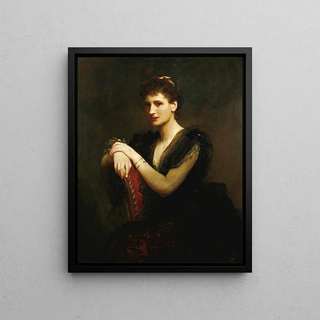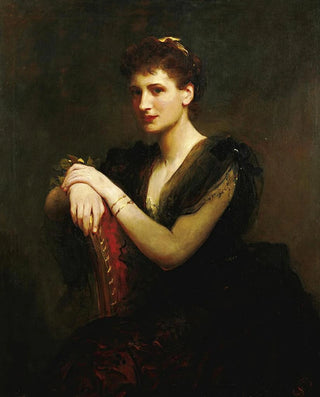Art print | Portrait of a seated lady - James Sant


View from behind

Frame (optional)
The artwork "Portrait of a seated lady" by James Sant is an invitation to immerse oneself in a world where beauty and elegance meet in perfect harmony. This painting, created in the 19th century, captures the essence of an era when portraiture was a privileged means of artistic expression. The delicacy of the lady's features, the subtlety of the colors, and the richness of the details evoke an intimate atmosphere, allowing the viewer to ponder the identity and story of this mysterious woman. This portrait does not merely depict a figure; it tells a story—of a time, a place, and a gaze that transcends time.
Style and uniqueness of the work
James Sant's style is distinguished by its striking realism and meticulous attention to detail. In "Portrait of a seated lady," the artist manages to capture not only the physical appearance of his model but also a palpable emotion emanating from the canvas. The composition is carefully arranged, highlighting the graceful posture of the lady, who appears both pensive and serene. The interplay of light and shadow, along with the soft color palette, helps create an atmosphere filled with melancholy and contemplation. Every brushstroke is deliberate, every nuance carefully chosen, demonstrating Sant's exceptional craftsmanship. This portrait is a true ode to femininity, revealing the psychological depth of the model while celebrating classical beauty.
The artist and his influence
James Sant, born in 1820, was a British artist whose work was widely recognized during the 19th century. Trained at the Royal Academy, he established himself as one of the leading portraitists of his time. His style, influenced by Romanticism and realism, left a mark on a generation of artists. Sant combined impeccable technique with artistic sensitivity, allowing him to capture the soul of his subjects with rare intensity. His influence extends beyond his era, inspiring many contemporary artists who seek to explore the subtleties of human representation. "Portrait of a seated lady" is an emblematic example of his

Matte finish

View from behind

Frame (optional)
The artwork "Portrait of a seated lady" by James Sant is an invitation to immerse oneself in a world where beauty and elegance meet in perfect harmony. This painting, created in the 19th century, captures the essence of an era when portraiture was a privileged means of artistic expression. The delicacy of the lady's features, the subtlety of the colors, and the richness of the details evoke an intimate atmosphere, allowing the viewer to ponder the identity and story of this mysterious woman. This portrait does not merely depict a figure; it tells a story—of a time, a place, and a gaze that transcends time.
Style and uniqueness of the work
James Sant's style is distinguished by its striking realism and meticulous attention to detail. In "Portrait of a seated lady," the artist manages to capture not only the physical appearance of his model but also a palpable emotion emanating from the canvas. The composition is carefully arranged, highlighting the graceful posture of the lady, who appears both pensive and serene. The interplay of light and shadow, along with the soft color palette, helps create an atmosphere filled with melancholy and contemplation. Every brushstroke is deliberate, every nuance carefully chosen, demonstrating Sant's exceptional craftsmanship. This portrait is a true ode to femininity, revealing the psychological depth of the model while celebrating classical beauty.
The artist and his influence
James Sant, born in 1820, was a British artist whose work was widely recognized during the 19th century. Trained at the Royal Academy, he established himself as one of the leading portraitists of his time. His style, influenced by Romanticism and realism, left a mark on a generation of artists. Sant combined impeccable technique with artistic sensitivity, allowing him to capture the soul of his subjects with rare intensity. His influence extends beyond his era, inspiring many contemporary artists who seek to explore the subtleties of human representation. "Portrait of a seated lady" is an emblematic example of his






